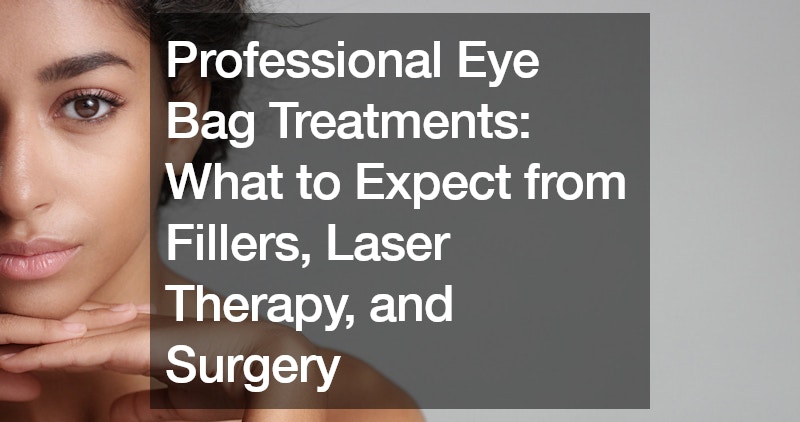
Eye bags, those pesky pouches under the eyes, can affect anyone, regardless of age or lifestyle. They often make one appear tired or older than they actually are. While there are numerous over-the-counter solutions and home remedies available, sometimes professional eye bag treatments are necessary for more stubborn cases. This article will delve into three popular professional treatments: fillers, laser therapy, and surgery, outlining what you can expect from each.
Understanding Eye Bags
Before exploring treatment options, it’s important to understand what causes eye bags. The primary factors include genetics, aging, fluid retention, lack of sleep, and lifestyle choices such as diet and smoking. As we age, the muscles and tissues around the eyes weaken. The fat that was supporting the eyes can move into the lower eyelids, leading to puffiness. The accumulation of fluid in the space below the eyes also adds to the swelling.
Fillers: A Minimally Invasive Option
Fillers are one of the most popular non-surgical eye bag treatments. They are ideal for individuals who have mild to moderate eye bags or hollow under-eye areas. Fillers, typically made from hyaluronic acid, are injected into the skin to add volume and smooth out the appearance of under-eye bags.
What to Expect:
Consultation: During the initial consultation, a dermatologist or plastic surgeon will assess your under-eye area and discuss your medical history to determine if you are a suitable candidate for fillers.
Procedure: The actual procedure is relatively quick, usually taking about 15-30 minutes. A numbing cream may be applied to the area to minimize discomfort. Using a fine needle, the filler is then injected into the targeted areas.
Results and Recovery: Results from fillers are immediate, with some minor swelling and bruising that typically subside within a few days. The effects can last anywhere from six months to a year, depending on the type of filler used and individual factors.
Aftercare: Post-treatment care involves avoiding strenuous activities and exposure to extreme heat for a couple of days. Patients are usually advised to sleep with their head elevated to minimize swelling.
Laser Therapy: Advanced Skin Resurfacing
Laser therapy is another effective option for treating under-eye bags, especially those caused by excess pigmentation or skin laxity. This treatment involves using laser technology to resurface the skin, promoting collagen production and tightening the area around the eyes.
What to Expect:
Consultation: Similar to fillers, the process begins with a consultation to evaluate your skin type and condition. The specialist will determine the most suitable laser treatment for your needs.
Procedure: Depending on the type of laser used (e.g., CO2, erbium), the procedure can vary. Generally, a numbing cream is applied, and the laser is then used to target the under-eye area. The treatment usually lasts about 30-60 minutes.
Results and Recovery: Initial results may be visible within a few days, but full results typically take a few weeks as the skin heals and new collagen forms. Recovery can involve redness and swelling, which subside over a week or two. Patients may need multiple sessions for optimal results.
Aftercare: Post-treatment care includes avoiding sun exposure, using gentle skin care products, and applying prescribed ointments to aid healing.
Surgery: Permanent Solution for Severe Cases
For severe eye bags, especially those caused by significant fat displacement or skin laxity, surgical intervention might be the best option. Blepharoplasty, commonly known as eyelid surgery, is a procedure that removes or repositions fat, muscle, and skin to create a smoother and more youthful appearance.
What to Expect:
Consultation: A thorough consultation with a plastic surgeon is essential. The surgeon will review your medical history, examine your under-eye area, and discuss your goals and expectations.
Procedure: Blepharoplasty is performed under local anesthesia with sedation or general anesthesia. The surgeon makes incisions either inside the lower eyelid or just below the eyelashes, removes or repositions the excess fat, and tightens the skin. The procedure usually takes 1-2 hours.
Results and Recovery: Initial swelling and bruising can last for a couple of weeks, but most patients see a significant improvement within a month. Full recovery can take a few months, with results that can last for several years.
Aftercare: Post-surgery care includes applying cold compresses to reduce swelling, keeping the head elevated, and following the surgeon’s instructions on cleaning and caring for the incision sites.
Choosing the Right Treatment
Selecting the appropriate eye bag treatment depends on various factors, including the severity of the eye bags, the underlying cause, and individual preferences. It’s crucial to consult with a qualified specialist who can provide personalized recommendations based on a thorough assessment.
Conclusion
Professional eye bag treatments offer effective solutions for those struggling with persistent under-eye puffiness. Whether you opt for fillers, laser therapy, or surgery, each treatment has its own set of benefits and considerations. Understanding what to expect from these procedures can help you make an informed decision and achieve the desired results. By addressing eye bags with professional treatments, you can enjoy a refreshed and rejuvenated appearance, boosting your confidence and overall well-being.
.


